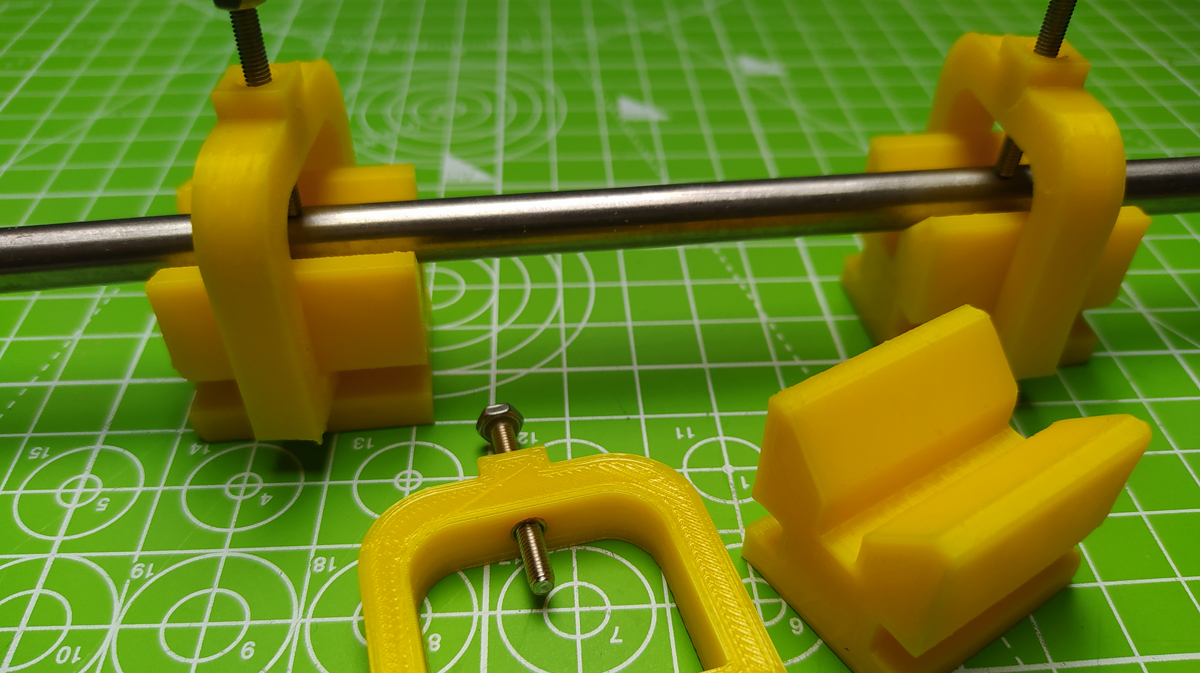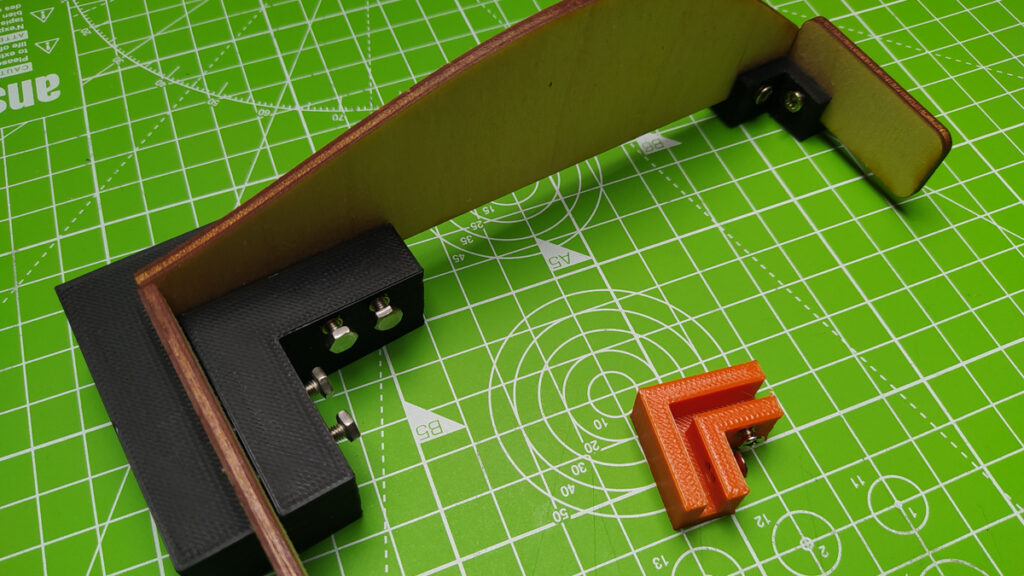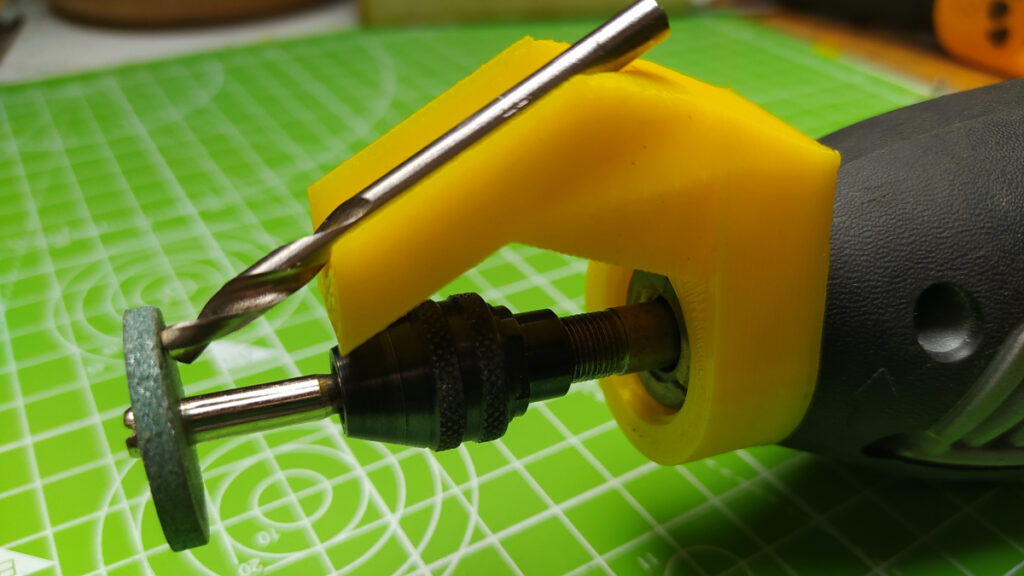
One of the first functional 3D prints this author ever made was a set of small thumb-wheels that fit over the adjustment nuts on his 3D printer bed (Figure 1). This bypassed the need to find a tiny spanner every time he want to adjust the bed on the printer, and made the process much quicker. He would probably, with hindsight, redesign these a little larger now. However, as one of the first prints he undertook, they still perform well to this day.
Making accessories for other machines has been a constant theme of our more functional 3D prints. One common job is printing custom clamps for use on our manual milling machine or CNC router. It seems that you can never have enough clamps and, for smaller machines, using a 3D print with a strong, high amount of infill is perfectly acceptable. In Figure 2, the small low-profile clamps work really well, are incredibly cheap to make, and can be printed quite quickly. While we don’t recommend crashing the CNC head into a clamp, they are easily replaced if damaged.


One of the beauties of CNC-type machines, laser cutters, CNC routers, and 3D printers is their accuracy. One of the first and most simple tools we make a lot on the 3D printer is a simple angle or square. We designed it with the point of the external corner cut away so it can be used in internal corners that perhaps we are gluing together without sticking the 3D print to the object. Using a combination of the square and a couple of clamps, it’s pretty useful for enabling accurate gluing. Similarly, we printed a small gap on the internal angle so that it can still be used on the outside of an object, even if the object has a small radius. Whilst we have a stack of these at 90 degrees, it’s also pretty easy to make any particular angle you might need to help you repeatedly set or glue items.
It’s hip to be square! In Figure 2 you can see an adaption of the simple 90-degree angle idea. The black piece is again a 90° angle, but underneath it has a parallel raised section on one of the arms, designed to slot into the tee slots on our CNC router. This is a really useful tool that can be clamped into a position on the router bed, and then workpieces can be placed quickly into it and we know that the workpiece is square to the bed/axis of the machine. It’s particularly useful if you need to repeatedly place the same size stock in the same position to create multiples of the same item, or indeed if you have a regular-sided object that you need to rotate and perform machine operation on multiple faces. You can also use it to zero the tool into the corner of the angle and then hold circular work in a known relative position to the zero point. Figure 4 shows a small aluminium chassis (made for a PocketQube-class satellite) which had the features of each side machined, whilst rotated in a similar jig. Whilst there are more accurate ways of doing setups for machining, this approach can return good results quickly and within reasonable tolerances.

Finally, for 90-degree angled tools, we made these clamps that help hold specific stock at 90 degrees. They are designed to receive 3.125 mm plywood which we often use in laser-cutting projects. The design is a simple 90-degree slot, but is sized accurately so the wood is a reasonably firm sliding fit into the clamp. We’ve then added some threaded inserts into the printed holes, and they can now take M3 bolts to be hand-tightened onto the workpieces to make sure everything stays in place. For accurately assembling small butt joints, these work very well (Figure 5).

Vee blocks are more commonly made from steel, rather than 3D-printed, and are used in all manner of machining tasks and also for accurate marking out of work etc. One use is that they can clamp and hold round bar stock very well and same size collections of vee blocks are often used to hold longer workpieces. We needed three matching vee blocks that we didn’t have in our collection of metal ones and, as the job didn’t require huge accuracy (as in we didn’t need to machine the part to 0.02 mm, but rather a 0.1 mm tolerance would suffice), 3D-printed vee blocks are a cheap and quick replacement (Figure 7).

We quickly CAD’d the block geometry in FreeCAD as a simple extrusion, and we made a small chamfer on one end. The chamfer end of the block is the face that sits on the print bed. Adding the small chamfer means that any sagging of the first layers of the print, often referred to as 'elephant’s foot', is absorbed by the chamfer, then the base and vee sides of the block don’t have any lip on them. It’s a quick and simple way to increase their accuracy. We went the whole hog with the vee block design, and also designed a clamp that fits into the side rail slots of the vee block. The clamp section again has a thermal insert pressed into it so that it can have an M3 bolt inserted, and this can apply the clamping force down onto the workpiece. The clamping force, in this instance, is therefore pushing up into the clamp, so we made sure to place the insert inside the clamp to maximise the strength.

A simple tool we love, which is available in multiple different forms on sites such as Thingiverse and GrabCAD, the Dremel drill-sharpening adapter is a really useful little device that enables drills to be quickly reconditioned. Again, this is in no way as accurate as a proper drill-sharpening grinding system but, for the average use case where absolute accuracy is not that critical, it’s a perfect way to clean up a dull drill bit, or even to totally reform a broken one. Searching online, you can find many variants of this little tool, and you should be able to find one that matches your Dremel or other brand rotary tool. The printed tool threads onto the threaded adapter on the Dremel, and you insert a grinding wheel/stone accessory. Holding the broken or dull drill bit in the vee groove presents the drill at the correct angle; this then allows you to rotate the drill end against the grinding wheel and sharpen the bit. In Figure 8, you can see the arrangement – this 5 mm drill bit had been previously snapped in half, but was quickly sharpened back to a usable standard.

Sticking with Dremel and rotary tool accessories, there are lots of 3D-printable projects to be found online that increase the use cases of these tools. A simple project that we found online was an accessory that clamped a Dremel 3000 to a work surface. This larger print took around two hours to print, but is an excellent accessory that allows hands-free usage of the Dremel – particularly useful when sanding or grinding small objects. Our version was designed to fit our older Dremel 3000, but looking around online, people have modelled similar clamps for many models of Dremel and other brands of rotary tool.

Finally, continuing the theme of expanding the use cases of tools, one final functional 3D print that we have done is a small holder for screwdriver bits. We have numerous sets of the 4 mm hexagonal shanked screwdriver bits, and occasionally we have ended up using just the bits with a small pair of pliers to turn it from the side, enabling access to a difficult-to-reach fastener. This is probably not recommended, and it’s easy to drop a bit into whatever you are working on, so we quickly designed and printed a low-profile bit holder. A simple hexagonal block with a shaft that can receive the 4 mm bits is finished with, again, a thermal insert on the side in which we can use a grub screw to clamp the bit in, making sure we don’t lose it (Figure 9). It’s incredibly handy occasionally, and a great tool to print multiples of and give away as a gift to other makers! At some point we will experiment with embedding a magnet into the print as an alternate method of bit holding.

We have put all the files for the tools, jigs, and clamps that we have designed on Thingiverse, and those designed by others can be found available for use online. That said, these simple prints are great opportunities to learn a few basic CAD skills!





